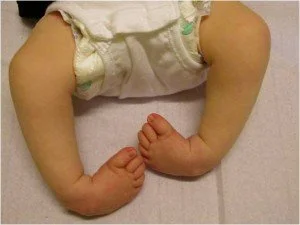Clubfeet
The 3rd June was World Clubfoot Day, which aims to raise awareness of clubfeet and the management of this congenital condition. Read on to find out more about clubfeet and how it is managed.
What is Clubfoot?
Lots of children may be born with feet that turn slightly inwards or outwards; however, their feet are shaped normally, are fully flexible and their foot position resolves with minimal or no intervention by about 6 weeks after birth. This is called positional clubfeet and is considered a ‘packaging disorder’ (ie: the feet end up positioned this way due to lack of room in the womb during the last few weeks of pregnancy). Although physiotherapy can help with these feet, this is not the type of clubfoot we are talking about in this article… Congenital Talipes Equinovarus (CTEV), aka ‘structural’ clubfoot, is a more complex but treatable birth deformity in which the bones, joints and muscles of the foot and lower leg develop incorrectly in utero, resulting in the foot being twisted inward and down at birth. It is the most commonly occurring congenital orthopaedic deformity, and affects 1 in 1000 babies. Structural clubfoot can occur in one foot or in both feet, and occurs more often in boys than girls.
There is no known cause for CTEV, but the deformity is thought to occur sometime in the second trimester. There can be a family history of clubfeet. Structural clubfeet can be diagnosed as early as the second trimester during the 20 week ultrasound scan, or may be diagnosed at birth.
Most children with CTEV have no other congenital or developmental conditions. For a very small number of children, clubfoot can occur with other conditions such as spina bifida or arthrogryposis (a condition causing multiple congenital joint contractures).
How is it treated?
Clubfoot management has improved significantly in the last few decades, and is now easily treated using minimally invasive methods and minor procedures.
The current ‘gold-standard’ treatment method for clubfeet is to use the Ponseti method, developed by Professor Ignacio Ponseti from Iowa, USA. The Ponseti method involves a series of gentle manipulations of the foot and ankle that help to reposition the bones and stretch the soft tissue, which are held in place by plaster casts. Babies with clubfeet will require approximately 2-6 plaster casts that gradually manipulate the feet into a corrected position. Many babies (about 80%) will then also need a minor procedure called a tenotomy, which lengthens the Achilles tendon and fully corrects the foot position. After the Achilles tendon has healed from the tenotomy, which takes 3 weeks, the baby is then placed into special boots which are connected to each other by a bar to help to maintain this corrected position as the child grows and therefore prevent the deformity from relapsing, or occurring again. These boots and bar are worn full time for 3 months, and then usually only overnight for between 3-5 years.
What are the outcomes for children with clubfeet?Using the Ponseti method, we aim to achieve:
Full correction of the position of the feet
Flexible and pain free feet
Normal walking pattern
Normal motor abilities eg: running, jumping, etc
Our physiotherapists at Move and Play Paediatric Therapy are experienced in the management of clubfeet and in the Ponseti method.If you have concerns about your child’s feet, or if you baby has been diagnosed with clubfeet, please don’t hesitate to contact us.Where can I find more information?
Aussie Clubfoot Kids - http://www.clubfootaustralia.com/
To Parents of Children Born with Clubfeet, by Professor Ignacio Ponseti - https://uichildrens.org/health-library/parents-children-born-clubfeet
Ponseti International - http://www.ponseti.info/


